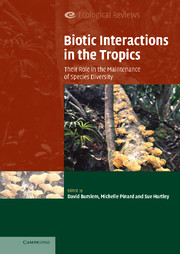Book contents
- Frontmatter
- Contents
- List of contributors
- Preface
- PART I Plant–plant interactions
- PART II Plant–microbe interactions
- 6 Dimensions of plant disease in tropical forests
- 7 Mycorrhizas and ecosystem processes in tropical rain forest: implications for diversity
- 8 An overview of arbuscular mycorrhizal fungal composition, distribution and host effects from a tropical moist forest
- 9 Tropical plants as chimera: some implications of foliar endophytic fungi for the study of host-plant defence, physiology and genetics
- PART III Plant–animal interactions
- PART IV Biotic interactions in human-dominated landscapes
- Index
- References
9 - Tropical plants as chimera: some implications of foliar endophytic fungi for the study of host-plant defence, physiology and genetics
Published online by Cambridge University Press: 25 August 2009
- Frontmatter
- Contents
- List of contributors
- Preface
- PART I Plant–plant interactions
- PART II Plant–microbe interactions
- 6 Dimensions of plant disease in tropical forests
- 7 Mycorrhizas and ecosystem processes in tropical rain forest: implications for diversity
- 8 An overview of arbuscular mycorrhizal fungal composition, distribution and host effects from a tropical moist forest
- 9 Tropical plants as chimera: some implications of foliar endophytic fungi for the study of host-plant defence, physiology and genetics
- PART III Plant–animal interactions
- PART IV Biotic interactions in human-dominated landscapes
- Index
- References
Summary
Introduction
Fungal endophytes are defined as those fungi that live inside plant tissues (e.g. roots, stems, leaves) without causing apparent harm to their host (see Wilson 1995). Although we will also mention stem-associated endophytes (see Evans et al. 2003) and endophytes associated with roots (mycorrhizae; see Herre et al., this volume), throughout this chapter, we will focus primarily on the implications of recent studies of the endophytic fungi that live inside plant leaf tissue. These foliar endophytes are extremely diverse phylogenetically and have been documented in nearly all plants sampled (e.g. mosses, liverworts, ferns, conifers and angiosperms; Carroll 1988; Clay 1988; Petrini 1991; Schultess & Faeth 1998; Frohlich & Hyde 1999; Stone et al. 2000; Arnold et al. 2000; Arnold 2002; Arnold et al. 2003; Davis et al. 2003). Despite the growing recognition of their wide distribution across plant taxa, basic attributes of their biology are still poorly understood. Specifically, endophyte diversity, distributions, life cycles, interactions with hosts and other fungi, and their net chemical, physiological and ecological influences are only beginning to be appreciated and studied. This is particularly true in the extremely diverse tropics.
The best-studied endophytes are ascomycetes belonging to the family Clavicipitaceae. These fungi grow throughout the aboveground tissues of some temperate grass species (e.g. Festuca arundinacea, see Clay & Schardl 2002). Typically, in infected individuals, a single fungal genotype infects a single plant individual.
- Type
- Chapter
- Information
- Biotic Interactions in the TropicsTheir Role in the Maintenance of Species Diversity, pp. 226 - 238Publisher: Cambridge University PressPrint publication year: 2005
References
- 16
- Cited by



